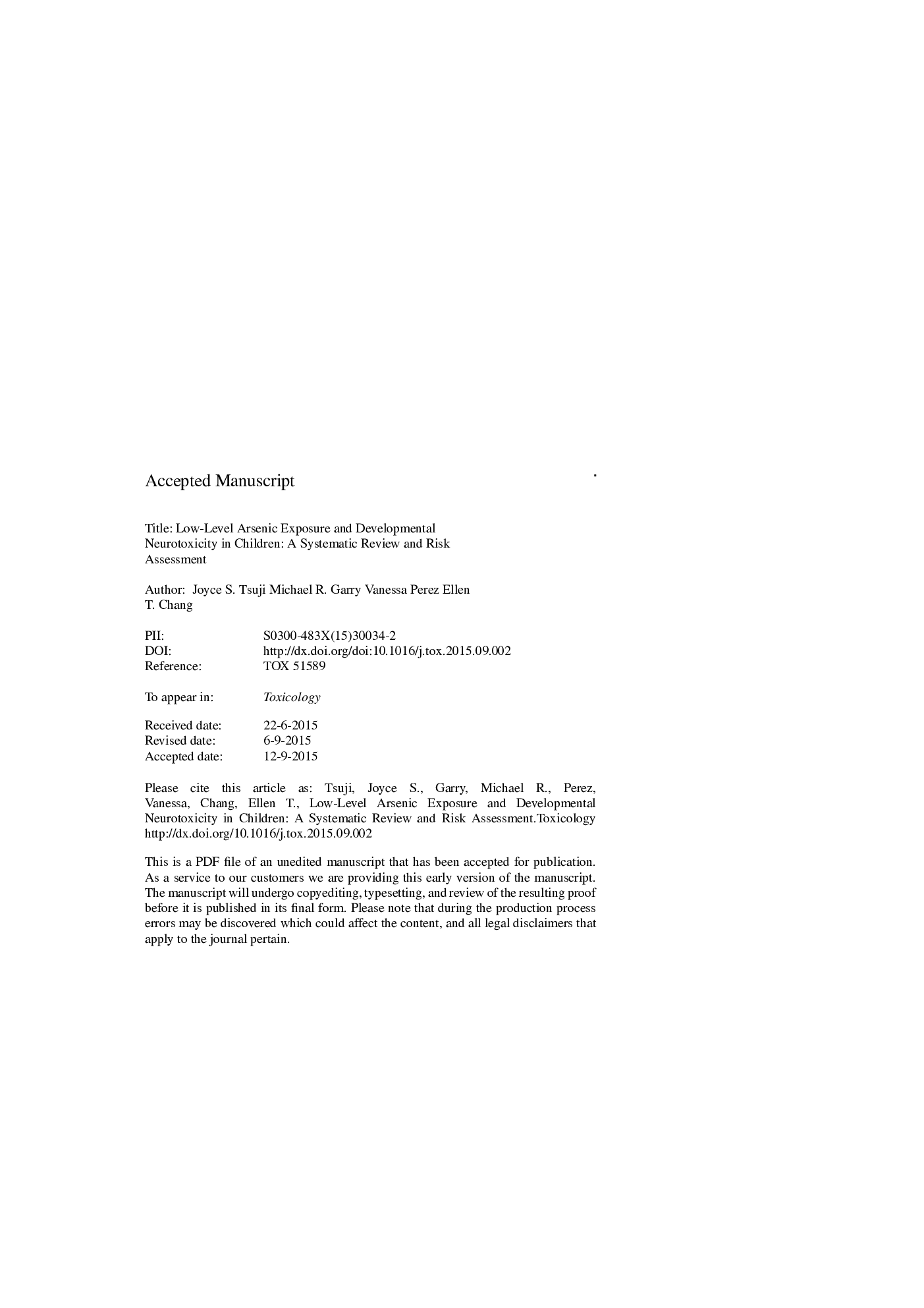| کد مقاله | کد نشریه | سال انتشار | مقاله انگلیسی | نسخه تمام متن |
|---|---|---|---|---|
| 5859069 | 1562319 | 2015 | 66 صفحه PDF | دانلود رایگان |
عنوان انگلیسی مقاله ISI
Low-level arsenic exposure and developmental neurotoxicity in children: A systematic review and risk assessment
ترجمه فارسی عنوان
قرار گرفتن در معرض آرسنیک سطح پایین و عصبی رشدی در کودکان: بررسی سیستماتیک و ارزیابی ریسک
دانلود مقاله + سفارش ترجمه
دانلود مقاله ISI انگلیسی
رایگان برای ایرانیان
کلمات کلیدی
RSPMPPVTRfDEPAMMAWPPSINHANESWISCBSIDLOAELCATNOAELDMAQRAArsenic - آرسنیکSES - آنU.S. Environmental Protection Agency - آژانس حفاظت از محیط زیست ایالات متحدهQuantitative risk assessment - ارزیابی ریسکی کمیdimethylarsenic acid - اسید دیمتیلارسنیکmonomethylarsonic acid - اسید مونومیتیلارسونیکstandard deviation - انحراف معیارNational Health and Nutrition Examination Survey - بررسی بهداشت و تغذیه ملیintelligence quotient - بهره هوشیPeabody Picture Vocabulary Test - تست واژگان تصویر Peabodyneurodevelopment - توسعه عصبیHome - خانهReference dose - دوز مرجعLowest-observed-adverse-effect level - سطح پایین ترین مشاهده شده - اثر ناخوشایندNeurotoxicity - سمیت عصبیbody mass index - شاخص توده بدنBMI - شاخص توده بدنیconfidence interval - فاصله اطمینانBayley Scales of Infant Development - مقیاس های بیلی توسعه ی نوزادانWechsler Intelligence Scale for Children - مقیاس هوش وکسلر برای کودکانno-observed-adverse-effect level - هیچ عارضه ای مشاهده نشدWAIS - وایسsocioeconomic status - وضعیت اجتماعی و اقتصادیWechsler Preschool and Primary Scale of Intelligence - پیش دبستانی و مقیاس اطلاعات اولیه WechslerChildren - کودکان
موضوعات مرتبط
علوم زیستی و بیوفناوری
علوم محیط زیست
بهداشت، سم شناسی و جهش زایی
چکیده انگلیسی
Risk assessments of arsenic have focused on skin, bladder, and lung cancers and skin lesions as the sensitive cancer and non-cancer health endpoints, respectively; however, an increasing number of epidemiologic studies that can inform risk assessment have examined neurodevelopmental effects in children. We conducted a systematic review and risk assessment based on the epidemiologic literature on possible neurodevelopmental effects at lower arsenic exposures. Twenty-four cross-sectional, case-control, and cohort studies were identified that report on the association between low-level arsenic exposure (i.e., largely <100 μg/L of arsenic in drinking water) and neurological outcomes in children. Although the overall evidence does not consistently show a causal dose-response relationship at low doses, the most rigorously conducted studies from Bangladesh indicate possible inverse associations with cognitive function, predominantly involving concurrent arsenic exposure as measured by biomarkers (i.e., arsenic in urine or blood) and raw verbal test scores at ages 5-11 years. Issues such as non-comparability of outcome measures across studies; inaccuracies of biomarkers and other measures of inorganic arsenic exposure; potential effect modification by cultural practices; insufficient adjustment for nutritional deficiencies, maternal IQ, and other important confounders; and presence of other neurotoxicants in foreign populations limit generalizability to U.S. populations. Of the few U.S. studies available, the most rigorously conducted study did not find a consistent dose-response relationship between arsenic concentrations in tap water or toenails and decrements in IQ scores. Assuming that the strongest dose-response relationship from the most rigorous evidence from Bangladesh is generalizable to U.S. populations, possible reference doses were estimated in the range of 0.0004-0.001 mg/kg-day. These doses are higher than the U.S. Environmental Protection Agency reference dose for chronic lifetime exposure, thus indicating protectiveness of the existing value for potential neurotoxicity in children. This reference dose is undergoing revision as EPA considers various health endpoints in the reassessment of inorganic arsenic health risks.
ناشر
Database: Elsevier - ScienceDirect (ساینس دایرکت)
Journal: Toxicology - Volume 337, 4 November 2015, Pages 91-107
Journal: Toxicology - Volume 337, 4 November 2015, Pages 91-107
نویسندگان
Joyce S. Tsuji, Michael R. Garry, Vanessa Perez, Ellen T. Chang,
